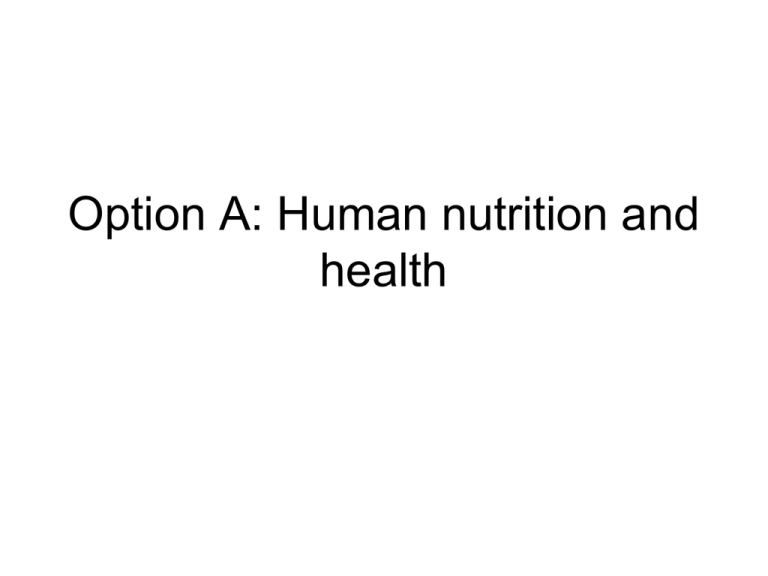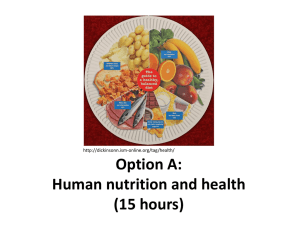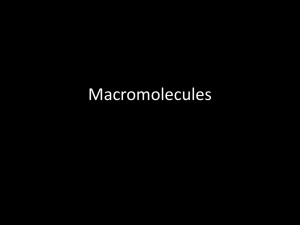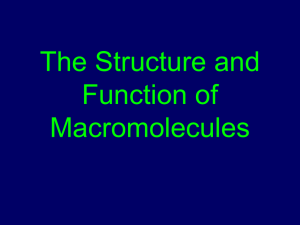Vitamins
advertisement

Option A: Human nutrition and
health
Define nutrient.
A Nutrient is a
chemical
substance
found in foods
that is used in
the human
body.
http://www.faqs.org/nutrition/images/nwaz_02_img0168.jpg
List the type of nutrients that are
essential in the human diet:
Amino acids are the
building blocks of protein . The
body has twenty different amino
acids that act as these building
blocks.
Nonessential amino acids are those
that the body can synthesize for
itself, provided there is enough
nitrogen, carbon, hydrogen, and
oxygen available.
Essential amino acids are those
supplied by the diet , since the
human body either cannot make
them at all or cannot make them in
sufficient quantity to meet its
needs.
Under normal conditions, eleven of
the amino acids are nonessential
and nine are essential.
Fatty Acids
Saturated fatty acids can align closely
together so lipids containing primarily
saturated fatty acids are usually solid at room
temperature (aka Fat).
The C=C double bond(s) in unsaturated fatty
acids causes the molecule to "bend" (a fatty
acid with one C=C bond is monounsaturated, a fatty acid with several C=C
bonds is poly-unsaturated.
Because they are "bent", unsaturated fatty
acids are less able to interact and lipids
contain primarily unsaturated fatty acids are
liquid at room temperature (oils).
•
Trans fatty acids are manufactured fats
created during a process called
hydrogenation, which is aimed at
stabilizing polyunsaturated oils to
prevent them from becoming rancid
and to keep them solid at room
temperature. They may be particularly
dangerous for the heart and may pose
a risk for certain cancers.
Hydrogenated fats are used in stick
margarine, fast foods, commercial
baked goods (donuts, cookies,
crackers), processed foods, and fried
foods.
Cis and trans are terms that refer to the arrangement of chains of carbon atoms across
the double bond. In the cis arrangement, the chains are on the same side of the double
bond, resulting in a kink. In the trans arrangement, the chains are on opposite sides of
the double bond, and the chain is straight.
•
•
Omega-3 fatty acids are a form of
polyunsaturated fat that the body
derives from food. Omega-3s (and
omega-6s) are known as essential
fatty acids (EFAs) because they are
important for good health. The body
cannot make these fatty acids on its
own so omega-3s must be obtained
from food. These different types of
acids can be obtained in foods such
as cold-water fish including tuna,
salmon, and mackerel. Other
important omega 3 fatty acids are
found in dark green leafy vegetables,
flaxseed oils, and certain vegetable
oils.
Omega-3 fatty acids have been found
to be beneficial for the heart. Positive
effects include anti-inflammatory and
anti-blood clotting actions, lowering
cholesterol and triglyceride levels, and
reducing blood pressure. These fatty
acids may also reduce the risks and
symptoms for other disorders
including diabetes, stroke, rheumatoid
arthritis, asthma, inflammatory bowel
disease, ulcerative colitis, some
cancers, and mental decline.
Minerals
These foods are all “mineral dense” foods. Find out which
minerals are in each food.
http://hachten.com/monavie/wp-content/images/19-fruits.jpg
Vitamins
A vitamin is an organic compound
required as a nutrient in tiny amounts by
an organism
http://www.childrenfirst.nhs.uk/teens/images/healthyeating/vitamins.jpg
• This might be a useful table to help
you fill in the Minerals lists.
http://www.healthalternatives2000.com
/minerals-nutrition-chart.html
Make a table!
Vitamin
A
B1
B2
B3
B12
C
D
E
Name
Use
Deficiency
disease
Too
much
RDA
Good
source
Water
Roughage / Fibre
Consists mainly of Cellulose
which is insoluble and
indigestible by animals. Forms
bulk which allows the gut to
move the food.
Not enough fibre causes
constipation in the short term,
and may lead to spastic colon in
long term and cancers of the gut
due to build up of poisons.
Go once a day!
Good sources: Fruit and
vegetables.
http://fitness.resourcesforattorneys.com/images/dietary-fiber.jpg
Outline the consequences of protein
deficiency malnutrition.
• Protein deficiency is shortage of one or
more essential amino acids.
• The consequences are lack of blood
plasma proteins and subsequent tissue
fluid retention, with swelling of the
abdomen.
• Development of children is likely to be
both mentally and physically retarded.
Kwashiorkor – a protein deficiency
• Kwashiorkor is a condition that
affects children who belong to
areas that have experienced
shortage of food. This is usually
places where famine has struck.
Among the lesser educated
classes of society also
Kwashiorkor is a fairly common
problem since the lack of
awareness about a balanced diet
often leads to a an inadequate
consumption of proteins.
Explain the causes and consequences
of phenylketonuria (PKU) and how
early diagnosis and a special diet can
reduce the consequences.
• Phenylketonuria (PKU) is an autosomal
recessive genetic disorder characterized by a
deficiency in the hepatic enzyme phenylalanine
hydroxylase (PAH) This enzyme is necessary to
metabolize the amino acid phenylalanine ('Phe')
to the amino acid tyrosine. When PAH is
deficient, phenylalanine accumulates and is
converted into phenylpyruvate (also known as
phenylketone), which is detected in the urine.
• It can be managed by a patient controlling their
diet with little or no side effects, just
inconvenience with managing the treatment. If
however the condition was left untreated, it can
cause problems with brain development, leading
to progressive mental retardation, brain damage,
and seizures.
• There is currently no cure for this disease,
although some treatments are available with
varying success rates. PKU is generally
detected through newborn screening.
Evaluate the health consequences
of diets rich in the different types of
fatty acid.
• Dietary studies are difficult to control sufficiently to gain really
reliable data. Where data are produced it may not be possible to
conclude causal relationships from correlation. Care must be taken
to think critically about nutrition-based news stories and articles.
Distinguish between minerals and
vitamins in terms of their chemical
nature.
• Minerals are elements in ionic
form.
• Vitamins are organic
compounds.
Outline two of the methods that have been used to determine the
recommended daily intake of vitamin C.
• Some of the experiments used to determine
necessary levels of vitamin consumption
were done using conscientious objectors
during the second world war. This raises
ethical questions about trials in which the
experimental subjects could be harmed or
suffer.
Look at this website for detailed description
of what they did! It is fascinating.
http://ije.oxfordjournals.org/cgi/content/full/3
5/3/556
•
During World War II, 36 conscientious objectors
participated in a study of human starvation
conducted by Ancel Keys and his colleagues at
the University of Minnesota. The Minnesota
Starvation Experiment, as it was later known, was
a grueling study meant to gain insight into the
physical and psychologic effects of semistarvation
and the problem of refeeding civilians who had
been starved during the war. During the
experiment, the participants were subjected to
semistarvation in which most lost >25% of their
weight, and many experienced anemia, fatigue,
apathy, extreme weakness, irritability, neurological
deficits, and lower extremity edema. In 2003–
2004, 18 of the original 36 participants were still
alive and were interviewed. Many came from the
Historic Peace Churches (Mennonite, Brethren,
and Quaker), and all expressed strong convictions
about nonviolence and wanting to make a
meaningful contribution during the war. Despite
ethical issues about subjecting healthy humans to
starvation, the men interviewed were unanimous
in saying that they would do it all over again, even
after knowing the suffering that they had
experienced. After the experiment ended, many of
the participants went on to rebuilding war-torn
Europe, working in the ministries, diplomatic
careers, and other activities related to
nonviolence.
• Life magazine
photograph of
conscientious
objectors during
starvation
experiment. July 30,
1945. Volume 19,
Number 5, p. 43.
Credit: Wallace
Kirkland/Time Life
Pictures/Getty
Images
Animal trials on Vitamin C
• Guinea pig trials: observed the effect of
vitamin C concentration on collagen
structure. After periods of varying vitamin
C supplementation and measurement of
blood and urine vitamin C levels, guinea
pigs were sacrificed and the structure of
collagen fibres observed. Guinea pigs
with restricted vitamin C showed weaker
collagen.
• Think ethics! What is vivisection?
Can it be justified?
http://www.woodwindsanimalhotel.com/images/guinea-pig.jpg
What is rebound malnutrition?
• Rebound malnutrition can occur when a
normally adequate intake of a vitamin
follows a period of excessive intake and
excretion.
List the sources of vitamin D in
human diets.
• Vitamin D can be produced by skin as a
response to sunlight.
It also can be found (in a slightly different
form) in foods: fatty fish, fish oils, liver,
eggs and some mushrooms.
In some countries, milk is supplemented
with vitamin D.
Now using your food diary…..
Go to http://nutritiondata.self.com/
1. For the 24 hours you recorded in homework do a diet
analysis.
2. Make up an ‘ideal’ MacDonalds Day diet, of breakfast,
lunch afternoon snack and dinner. Each meal must be
different!
Answer the following questions:
• What was your diet good for?
• What mineral, vitamin or other nutrient was lacking in
your diet?
• What suggestions could you make to improve your diet?









